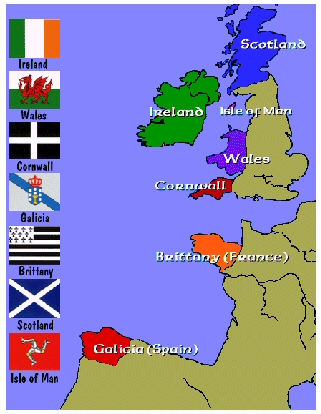What is a Celt and who are the Glasgow Celtics?The people who made up the various tribes of concern were called Galli by the Romans and Galatai or Keltoi by the Greeks, terms meaning barbarian. It is from the greek Keltoi that Celt is derived. Since no soft c exists in greek, Celt and Celtic and all permutations should be pronounced with a hard k sound.
It is interesting to note that when the British Empire was distinguishing itself as better and seperate from the rest of humanity, it was decided that British Latin should have different pronunciation from other spoken Latin. Therefore, one of these distinguishing pronunciational differences was to make many of the previously hard k sounds move to a soft s sound, hence the Glasgow and Boston Celtics. It is the view of many today that this soft c pronunciation should be reserved for sports teams since there is obviously nothing to link them with the original noble savegery and furor associated with the Celts.
The Six Celtic LanguagesThere was a unifying language spoken by the Celts, called not suprisingly, old Celtic. Philogists have shown the descendence of Celtic from the original Ur-language and from the Indo-European language tradition. In fact, the form of old Celtic was the closest cousin to Italic, the precursor of Latin.
The original wave of Celtic immigrants to the British Isles are called the q-Celts and spoke Goidelic. It is not known exactly when this immigration occurred but it may be placed somtime in the window of 2000 to 1200 BC. The label q-Celtic stems from the differences between this early Celtic tounge and Italic. Some of the differences between Italic and Celtic included that lack of a p in Celtic and an a in place of an the Italic o.
At a later date, a second wave of immigrants took to the British Isles, a wave of Celts referred to as the p-Celts speaking Brythonic. Goidelic led to the formation of the three Gaelic languages spoken in Ireland, Man and later Scotland. Brythonic gave rise to two British Isles languages, Welsh and Cornish, as well as surviving on the Continent in the form of Breton, spoken in Brittany.
The label q-Celtic stems from the differences between this early Celtic tounge and the latter formed p-Celtic. The differences between the two Celtic branches are simple in theoretical form. Take for example the word ekvos in Indo-European, meaning horse. In q-Celtic this was rendered as equos while in p-Celtic it became epos, the q sound being replaced with a p sound. Another example is the Latin qui who. In q-Celtic this rendered as cia while in p-Celtic it rendered as pwy. It should also be noted that there are still words common to the two Celtic subgroups.
As an aside, take note that when the Irish expansion into Pictish Britain occurred (see below), several colonies were established in present day Wales. The local inhabitants called the Irish arrivals gwyddel savages from which comes geídil and goidel and thus the Goidelic tounge.
The Irish and the Scots Are From the Same TribeIreland used to be divided up into five parts, the five fifths. There was a northern fifth, Ulster, a western fifth, Connaught, a southern fifth, Munster, an eastern fifth, Leinster and a middle fifth, Mide.
Click Here to see a map of the five fifths.
The Ulster Cycle is a set of stories which are grounded in the five fifths. Indeed, they are primarily concerned with Cú Chulainn, the Ulster hero and his king, Conor Mac Nessa in their wars against the king and queen of Connaught, Ailill and Maeve. These figures play a prominent role in the what may be the greatest story of the Ulster Cycle, the Táin Bó Cúailnge, The Cattle Raid of Cooley.
Sometime after 300 AD, Ulster became steadily less important in status among the five farthings and the ruling family of Mide, the Uí Néill Sons of Niall started to take over large parts of Connaught and most of Ulster. A similar move was made in Muster by the ruling family of Munster, the Eoganachta family. Thus was Ireland divided almost entirely into two halves.
The people of Ulster were pushed to a small coastal strip bordering the Irish Sea. The kingdom changed it's name to Dál Riata. Yet eventually Dál Riata fell under the rule and influence of the Uí Néill. This family, not content with the boundry presented by the sea, launched colonies across the Irish Sea into then Pictish Britain. Thus was Scotland founded, for it was these Uí Néill that the Romans called Scotti, not the original Picts.
Indeed, it was this Irish Expansion which led to Christianity in Scotland in 563 AD. St. Columba, the patron saint of Scotland, was a member of a powerful family in Dál Riata and in order to keep his ties in Ireland he settled on an island that was close to both Scotland and Ireland, Iona. Of course, even more bizarre is the fact that St. Patrick, the man responsible for bringing Christianity to Ireland in the first place, was from Wales.














